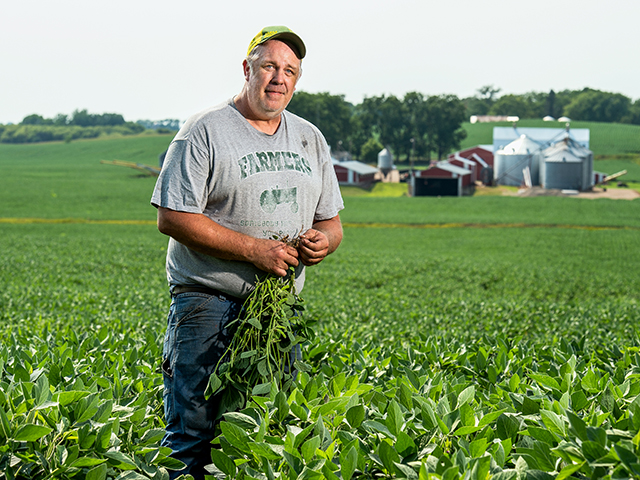Strip Till Economics
Strip-Till Uncovers Big Savings
Greg Entinger, New Prague, Minnesota, gave himself a huge pay raise when he switched from conventional tillage to strip-till in 2015. The extra money in his pocket comes from fewer trips across fields, reduced fertilizer rates and selling off unneeded equipment.
As a process engineer, Entinger's day job was making food processors' factories more efficient. He farmed nights and weekends with his dad. When his father died in 2012, Entinger challenged himself to streamline farming the same way he did in his day job. "I asked myself why I hadn't applied new technologies to streamline farming the way I did at work," he says.
Entinger, 50, now saves 155 hours of tractor time annually by strip-tilling corn and no-tilling soybeans compared to conventional till corn and soybeans.
COST-CUTTING MOVES
Fertilizer and equipment savings represent $38,729.40 annually (in 2020-21 prices). He sold several pieces of tillage equipment and the larger horsepower tractor. Applying P (phosphorus) and K (potassium) in bands instead of broadcasting, and increased microbial activity making N (nitrogen), P and K more plant-available has enabled him to cut fertilizer rates over time. Plus, Entinger estimates he's cut his fuel bill in half with fewer field passes and downsizing his equipment lineup.
"But, I focus on my time as a measure of efficiency: I'm actually home now for Thanksgiving -- no more late nights V-ripping," Entinger says.
"I'm an accidental conservationist," he continues. "I had never thought about all of this stuff." His 6 to 18% slopes and related erosion were his initial reasons for cutting tillage and banding nutrients in 6- x 6-inch zones. "In 2013, one rain event alone was 5.5 inches in 45 minutes. Half of my acreage went into prevent plant," he says. "The following year wasn't much better, with heavy rains and soil erosion. I had to change something."
P[L1] D[0x0] M[300x250] OOP[F] ADUNIT[] T[]
Entinger started researching strip-till rig options, settling on a 12-row, single-coulter Environmental Tillage Systems SoilWarrior 3100 to save on horsepower requirements. The cost ranges from $108,000 to $120,000, depending on number of rows and options.
Entinger no-tills soybeans into the previous year's undisturbed stubble and strip-tills corn. "By spring, soil microorganisms have partly deteriorated last year's corn stubble. And, as root masses decay, they leave highways for water, nutrients and earthworms," he points out.
"People still think I'm crazy when they see the residue I plant into. But, once the soybeans canopy, it looks like any other field."
Entinger spoon-feeds N in three doses: 20 pounds per acre when he bands the P and K while building strips in the fall, 5 pounds per acre at planting with starter fertilizer, 50 pounds per acre while using 32% N as a carrier when he sprays the burndown herbicide. The rest is sidedressed.
MACHINERY CHANGES
Initially, he used a Deere 7200 planter, but Entinger replaced it with a 40-foot Kinze 4900 to take advantage of downpressure, SharkTooth row cleaners and spiked closing wheels.
To help with the cost of the strip-till bar, he sold the following equipment:
Equipment Sold:
$58,550 JD 8770 300-hp tractor
$23,044 JD 455 drill
$25,266 JD 22110 36-foot field cultivator
$29,912 JD 5 x 30 disk ripper
- - - -
$136,772
Entinger kept his Deere 7260R, 7 Series 260-hp tractor since strip-tilling enabled him to shed the more powerful tractor.
Since switching to strip-till, he has observed a stark improvement in soil structure compared to a neighbor's compacted soil: "The difference in soil structure is like comparing ice cubes (his soil aggregates) to a solid block of ice," he says.
Over time, Entinger has cut P and K rates by 33 to 50%, as more active soil organisms and root mycorrhizae fungi make nutrients more plant-available. Soil microorganisms and mycorrhizae are known to thrive in undisturbed soils. In 2022, he's considering cutting P and K rates to 25% of what they once were.
In 2020-21, Entinger's fertilizer costs per acre were $45.50 for corn using a 33% reduced rate of P and K. On 500 acres, that's a $22.75-per-acre savings, or $11,375 annual savings in fertilizer costs. "This spring (2022), I'm down to 25% of where I once was," he says.
"I'm also trying to get down to about 145 pounds per acre of applied N. I'll use a nitrate test in coming years to see what is currently out there.
"This system has worked for me," Entinger adds, even with 19 soil types and 1 to 18% slopes in one of his 90-acre fields. "Each person has to figure out what works for his situation. I advise people to initially strip-till or no-till on 5 to 20 acres," he says. "Time and inputs are lower, and there's a learning curve."
"When I combine corn at the end of the season, there's no ripping to do, I just put my equipment away. I can't imagine going back to another pass after harvest," Entinger says. "In the spring, there is no more field cultivating; I just go plant. Your time is valuable."
[PF_0122]
(c) Copyright 2022 DTN, LLC. All rights reserved.



